Smartphone Application for Support Library Operations in the Internet of Things Era
DOI:
10.33395/sinkron.v8i2.12306Keywords:
Camera, Internet of Things, RFID, Smartphone, System ApplicationAbstract
The library can be referred to as a storage place for books and other references. The reference can be in the form of digital storage media. Libraries if not managed properly will cause chaos in the library organization. Many books were lost due to the entry and exit of books that were out of control. Currently, the library is not only a place to store books but can be maximized by managing and adding other digital devices. The use of Radio Frequency Identification (RFID) in libraries adds sophistication to the management of books and library items. In addition, currently many libraries have taken advantage of Internet of Things Technology, by adding various sensors and integrating with cloud-based storage devices. It provides a service that makes it easy for library members to find and track the current whereabouts of books. This research does not only create a library by providing hardware in the form of sensors to be installed in the library. This paper also proposes the use of smartphones as an alternative in replacing sensor hardware. This study uses a QR Code sensor to match the book you are looking for and simulates dancing a book in blocks and bookcases. with augmented reality. The purpose of this research is to make a smart library prototype to make it easier for library members to find books or other references. The results of the experiment to find books and DVDs that have been carried out achieve an accuracy of 83.33%.
Downloads
References
Ashrov, A., Marron, A., Weiss, G., & Wiener, G. (2015). A use-case for behavioral programming: An architecture in JavaScript and Blockly for interactive applications with cross-cutting scenarios. Science of Computer Programming, 98(P2), 268–292. https://doi.org/10.1016/j.scico.2014.01.017
Asim, M., Arif, M., & Rafiq, M. (2022). Applications of Internet of Things in university libraries of Pakistan: An empirical investigation. The Journal of Academic Librarianship, 48(6), 102613. https://doi.org/https://doi.org/10.1016/j.acalib.2022.102613
Bosse, S. (2018). A Unified System Modelling and Programming Language based on JavaScript and a Semantic Type System. Procedia Manufacturing, 24, 21–39. https://doi.org/10.1016/j.promfg.2018.06.005
Ding, S., Tukker, A., & Ward, H. (2023). Opportunities and risks of internet of things (IoT) technologies for circular business models: A literature review. Journal of Environmental Management, 336(August 2022), 117662. https://doi.org/10.1016/j.jenvman.2023.117662
Fagerstrøm, A., Eriksson, N., & Sigurdsson, V. (2020). Investigating the impact of Internet of Things services from a smartphone app on grocery shopping. Journal of Retailing and Consumer Services, 52(October 2018), 101927. https://doi.org/10.1016/j.jretconser.2019.101927
Hadianto, E., Amanda, D., Hindarto, D., Makmur, A., & Santoso, H. (2023). Design and Development of Coffee Machine Control System Using Fuzzy Logic. Sinkron, 8(1), 130–138. https://doi.org/10.33395/sinkron.v8i1.11917
Hindarto, D. (2022). Perbandingan Kinerja Akurasi Klasifikasi K-NN, NB dan DT pada APK Android. JATISI (Jurnal Teknik Informatika Dan Sistem Informasi), 9(1), 486–503. https://doi.org/10.35957/jatisi.v9i1.1542
Hindarto, D., & Handri Santoso. (2021). Android APK Identification using Non Neural Network and Neural Network Classifier. Journal of Computer Science and Informatics Engineering (J-Cosine), 5(2), 149–157. https://doi.org/10.29303/jcosine.v5i2.420
Hindarto, D., & Santoso, H. (2022). PERFORMANCE COMPARISON OF SUPERVISED LEARNING USING NON-NEURAL NETWORK AND NEURAL NETWORK. Janapati, 11, 49–62.
Kjeldsen, K., Nodeland, M., & Fagerstrøm, A. (2023). The relative impact of QR codes on omnichannel customer experience and purchase intention. Procedia Computer Science, 219, 1049–1056. https://doi.org/10.1016/j.procs.2023.01.383
Lau, S., Wiedmann, M., & Adalja, A. (2022). Consumer perceptions of QR code technology for enhanced fluid milk shelf-life information provision in a retail setting. JDS Communications, 3(6), 393–397. https://doi.org/10.3168/jdsc.2022-0256
Mohamed El Abd, N. (2023). Smart monitoring solution through internet of things utilization to achieve resilient preservation. Ain Shams Engineering Journal, 14(6), 102176. https://doi.org/https://doi.org/10.1016/j.asej.2023.102176
Pantelic, J., Son, Y. J., Staven, B., & Liu, Q. (2023). Cooking emission control with IoT sensors and connected air quality interventions for smart and healthy homes: Evaluation of effectiveness and energy consumption. Energy and Buildings, 286, 112932. https://doi.org/10.1016/j.enbuild.2023.112932
Qasim Mohammed, S., Najm Abdullah, M., & Sabah Al-Araji, A. (2023). One decade of radio frequency identification (RFID) Network Planning (RFID-NP). Measurement: Sensors, 26(December 2022), 100696. https://doi.org/10.1016/j.measen.2023.100696
Rejeb, A., Rejeb, K., Treiblmaier, H., Appolloni, A., Alghamdi, S., Alhasawi, Y., & Iranmanesh, M. (2023). The Internet of Things (IoT) in healthcare: Taking stock and moving forward. Internet of Things (Netherlands), 22(February), 100721. https://doi.org/10.1016/j.iot.2023.100721
Shankar, V. G., & Somani, G. (2016). Anti-Hijack: Runtime Detection of Malware Initiated Hijacking in Android. Physics Procedia, 78(December 2015), 587–594. https://doi.org/10.1016/j.procs.2016.02.105
Sze, E., Hindarto, D., & Wirayasa, I. K. A. (2022). Performance Comparison of Ultrasonic Sensor Accuracy in Measuring Distance. 7(4), 2556–2562.
Thouti, S., Venu, N., Rinku, D. R., Arora, A., & Rajeswaran, N. (2022). Investigation on identify the multiple issues in IoT devices using Convolutional Neural Network. Measurement: Sensors, 24(July), 100509. https://doi.org/10.1016/j.measen.2022.100509
Verma, D., Singh, K. R., Yadav, A. K., Nayak, V., Singh, J., Solanki, P. R., & Singh, R. P. (2022). Internet of things (IoT) in nano-integrated wearable biosensor devices for healthcare applications. Biosensors and Bioelectronics: X, 11(May), 100153. https://doi.org/10.1016/j.biosx.2022.100153
Downloads
How to Cite
Issue
Section
License
Copyright (c) 2023 Eko Hadianto, Djarot Hindarto, Haryono

This work is licensed under a Creative Commons Attribution-NonCommercial 4.0 International License.



























 Moraref
Moraref PKP Index
PKP Index Indonesia OneSearch
Indonesia OneSearch OCLC Worldcat
OCLC Worldcat Index Copernicus
Index Copernicus Scilit
Scilit




